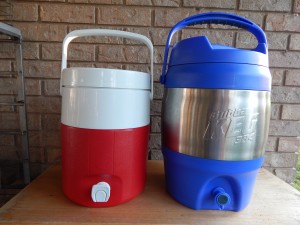Here is an example recipe for countertop partial mashing. This is my pale ale, presented in a 5-gallon (19-L) homebrew recipe formulated for either partial mashing with a 2-gallon cooler (main recipe) or a 3-gallon cooler (see option). Compared to a pale ale made with a straight extract-with-steeping-grains formulation, this beer has more aroma from the pale malt. Compared to some other partial mash methods, this uses more grains and less extract. Over 70% of the fermentables in this recipe come from the partial mash. Other recipes on this website formulated this way include Colby House Porter, Beelzeboss (“saison” brewed with Mt. Dew), Fimbulvinter Øl (winter warmer), and “Freya’s” Eyes (golden ale). Since this is a hoppy beer, I’ve also linked to some tips on dry hopping in the recipe.
Patrick Henry Pale Ale
American pale ale
by Chris Colby
Partial mash (countertop); English units
DESCRIPTION
This is my basic American-style pale ale. I’ve brewed (the all-grain version of) this recipe — slightly tweaking it every time — over 30 times and it’s a great “go-to” beer. I really like the combination of Centennial, Cascade and Amarillo late hops and I use this combo in most of my other pale-ale-like beers, including my sweet potato ESB. The only non-standard part of this recipe is the tiny amount of chocolate malt added. This changes the hue of the beer slightly, and can be omitted if you want.



Recent Comments